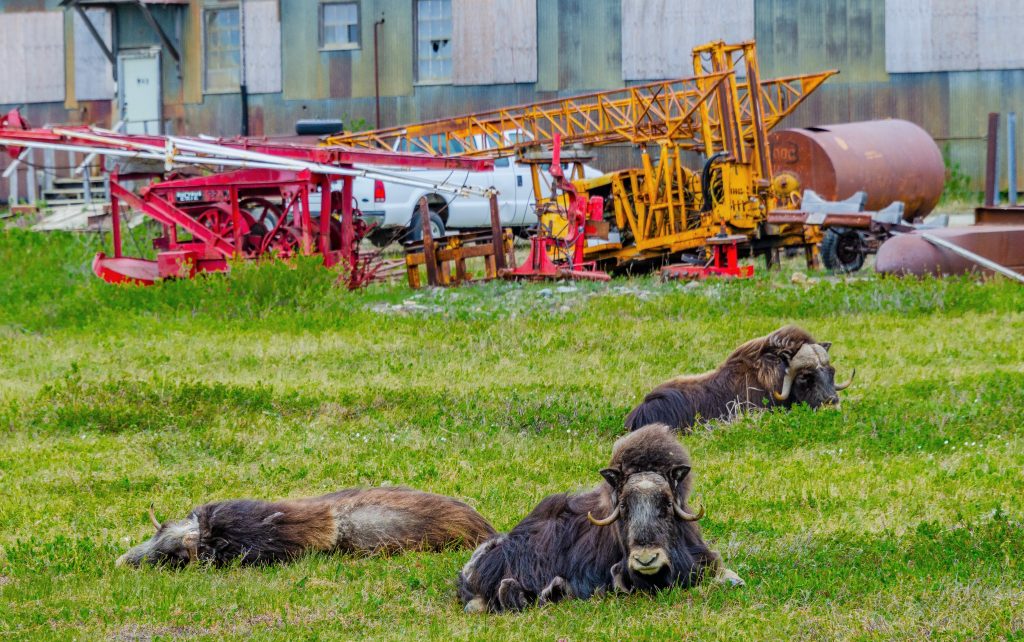Bull muskox spar by butting heads, sometimes running at each other full bore before colliding. Four inches of horn and three inches of bone protect the brain from injury during this violent contact.
The first time I encountered muskox in the wild I felt as spectacular as Tom Cruise dancing around in his underwear and football helmet in the movie Risky Business. I was skiing across the Arctic National Wildlife Refuge (ANWR) in March as mountains and the coastal plain glowed blue in the winter light. ANWR, long known as the battleground between wilderness and oil lovers, is the sort of place you can slow dance with your inner Frankenstein without the judgement of others. Better yet, it’s one of a handful of regions in Alaska you can see muskox. A herd of 15 grazed on a windswept rise above a frozen river ahead of me. A bull hoofed at the snow, then gently rammed heads with another member of his herd. I skied too close and the muskox ran a short distance, banded together in a half circle defense, and faced me. I watched, reveling in the fact I was witnessing a scene straight out of the Pleistocene Epoch, until the cold became too much.

The muskox were using a defense technique against me that had worked successfully during the more than 600,000 years their kind have been on Earth. By huddling together, with the young in the center, protected by the horns and hooves of the adults, they withstood attacks from a host of formidable and now extinct ice age predators. A muskox that broke away from this half-circle defenses was often killed, which cemented the importance of maintaining formation in the animal’s DNA. When Euro-American explorers, whalers, and traders came into the Arctic during the middle of the nineteenth century, the muskox’s defense proved worthless. Muskox were killed, often to the last member of their herd, standing their ground. By 1920, muskox were extirpated from Alaska and most of their home range. Small remnant populations hung on in Greenland and the high Arctic islands of Canada. Around then, agencies from the U.S., Denmark, Russia, and Canada began working together to keep the species from vanishing forever.
In 1930, 34 muskox were captured in Greenland, transported to holding pens in Fairbanks and, a few years later, to Nunivak Island in the Bering Sea. By the mid-1960s, the Nunivak herd had grown to 750 animals. In the ensuing years, Nunivak muskox were transported to Nelson Island, ANWR, Cape Thompson, the Seward Peninsula, and even Russia’s Taimyr Peninsula and Wrangel Island. Today, there are more than 5,000 muskox in Alaska. For the most part, herds appear to be relatively stable. In northeast Alaska, there’s been a decline likely caused by a number of grizzlies that have learned specialized hunting techniques. The meat, I’ve heard, tastes delicious.

For all their resiliency, muskox are prone to extreme population swings. The muskox of Banks Island illustrates the boom and bust cycle of the species startlingly well. When Vilhjalmur Stefansson explored Banks Island in Canada’s Arctic from 1914-1916, he saw no muskox. Stefansson did, however, find fossil evidence indicating that an abundant population of muskox had recently inhabited the island. He and others theorized that from the 1850s to the early 1900s, that Copper Inuit, while salvaging iron and wood from the abandoned ship the Investigator, killed most, if not all, of the island’s population. Others guessed freezing rain events and disease wiped out the animal. There were few if any sightings of muskox on Banks Island until the 1950s when a biologist spotted a lone bull. A few decades later, the population on Banks was skyrocketing. It peaked in 2001, when an aerial survey put the island’s population at 68,778 non-calf muskox. At the time, that was more than half the world’s population. Now, Banks Island’s population is plummeting. A 2014 survey stimates the island’s muskox at around 15,000, and it’s still declining. It appears climate change and disease are the main cause in mortality, but the rise and fall of Banks Island’s muskox still has many people scratching their heads.
If you want to see muskox in the wild, consider visiting Nome, a quaint drinking town with a small dog mushing problem. During the past decade, likely to avoid wolf and grizzly predation, around a hundred muskox have moved into Nome and the surrounding area. They generally show up in the early summer, after calving, and hang around until winter when they clear out to more wind-blown areas with less snow. With an extensive road system, Nome offers visiting wildlife nerds relatively easy viewing. However, Nome is well-known as a hotbed for alien abductions, so, be prepared to socialize with little green fellers. On Banks Island there have been no reports of ETs misbehaving as far as I’m aware of, but it is significantly more expensive and difficult to travel to.

Many Nome residents find the muskox challenging, and even dangerous, to share their town with. Since muskox are preyed on by wolves, they dislike dogs, and numerous pets and sled dogs have been wounded or fatally stomped and gored. Air and vehicle traffic has been blocked. People have been charged and threatened, and it seems it’s only a matter of time before someone gets hurt. Muskox are most dangerous during the rut in August and September and should be given a wide amount of space no matter what time of the year. Efforts to haze the animals out of town have been minimally successful.
You’re probably wondering what to do if you’re charged by a muskox. I’ve been charged by a variety of critters and each requires a different defense. Run from a moose. Don’t run from a bear. Play dead with a porcupine. Kiss a caribou. Express yourself using “I feel” messages to a wolf. Curse a mountain goat’s mother. Dance the macarena with a wolverine. In all honesty, I’m not entirely sure what the best defense is against an aggressive muskox, but I’ll tell you what worked for me the one time I was charged by a randy bull. It was early September in the western Arctic, and I was lonely, so I decided to try to make conversation with a cow muskox. The willows on a hill shook like King Kong was coming down the slope and a big bull muskox erupted out into the tundra where I was sitting—an adult male stands five feet at the shoulder and weighs up to 800 pounds. He motioned for the cow to rejoin his harem, which was watching the drama unfold from above, and then came toward me. I stood my ground and talked to him until he calmed enough to let me slowly back away. I’m pretty sure what really saved me, though, was that I hadn’t bathed for six weeks and smelled so disgusting he wasn’t willing to come any closer.
The muskox of Alaska, with their saga of extinction and repopulation, are a testament to both our capacity to destroy and conserve. To some, they’re a nuisance. To others, they’re an icon of the Arctic. To me, muskox are testament that there’s still hope for the future and the wildlife we share this planet with.


